- S.D. Eibar ready for maiden La Liga outing
- SD Eibar stengthen ahead of debut La Liga season
- Can ‘Super Mario’ live up to expectations in Madrid?
- MAN IN THE GROUND – Brentford 0 – 4 Osasuna
- Historic Basque derby welcomes S.D. Eibar to La Liga
- Munich to Madrid, via Brazil – Tony Kroos
- Rakitic in Spanish Switch
- Can Spain find redemption in Rio?
- Viva Espana! A season of redemption for Spanish football
- From the old to the new: who can fill the void in years to come for La Roja?
Córdoba and the Estadio Nuevo Arcángel
- Updated: 29 May, 2012
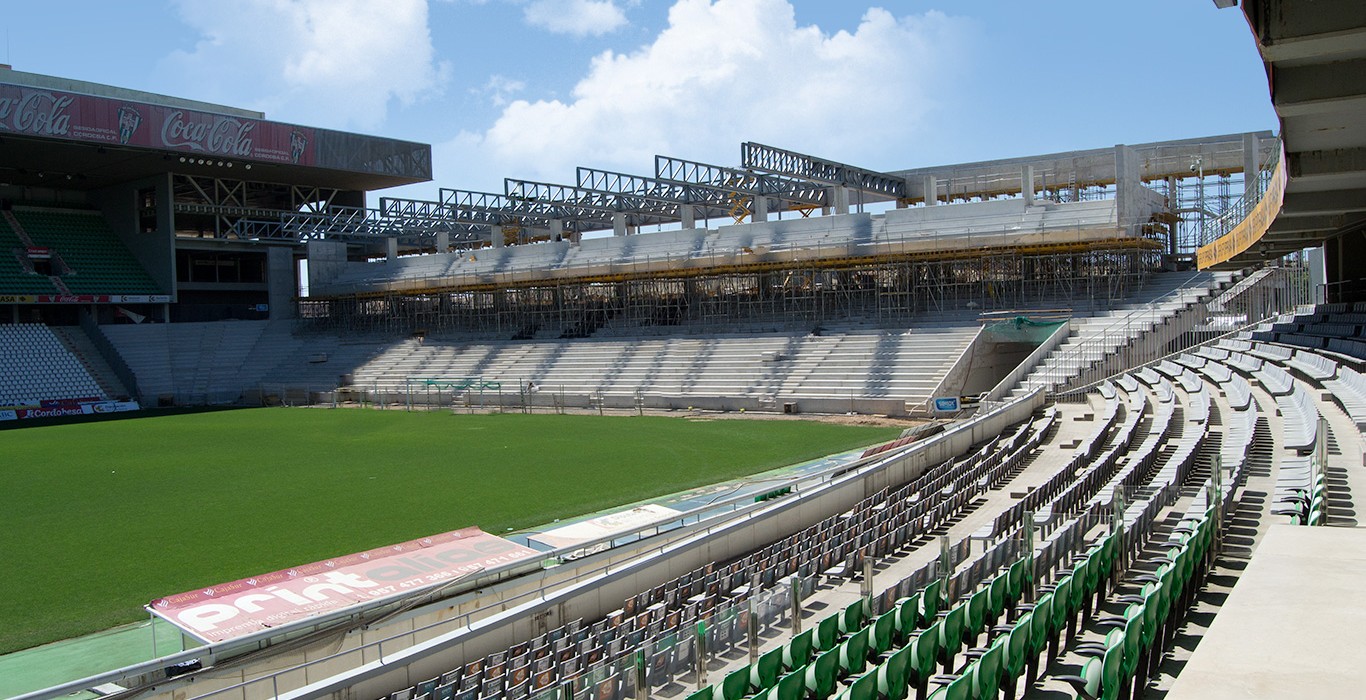

Córdoba is a city steeped in history. Through the ages, it has witnessed Roman and Islamic occupation which at the turn of the first millennium made it the largest city in the world. The decline and fall was rapid however and by the mid-sixteenth century, Córdoba was a backwater with little over 20,000 inhabitants. It’s back on its feet now and is a confident modern city with a fantastic old heart.
The football clubs that have represented the city can never claim to have been the biggest in the world, nor do they score highly on heritage, but they certainly have had their share of highs and lows.
Let’s start with Racing Club Deportivo Córdoba who was formed in 1929 and reached the Tercera in 1931, by which time they were playing their matches at the Estadio de America, a decent sized stadium on the site of the city’s former military barracks. In 1945, the club upped sticks and moved to a new stadium, built by and rented from the club president José Ramón de la Lastra y Hoces. The Estadio del Arcángel was built close to the north bank of the Rio Guadalquivir and was opened on 8 September 1945 with a match against Sevilla. Whilst things looked rosy on the pitch, problems were brewing behind the scenes.
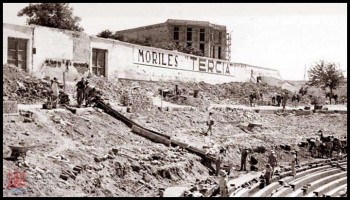 With the passing of the club president, Racing Córdoba’s debt grew to 1.5 million pesetas and unable to pay the rent to the family, the club moved out of the Estadio del Arcángel in 1953.
With the passing of the club president, Racing Córdoba’s debt grew to 1.5 million pesetas and unable to pay the rent to the family, the club moved out of the Estadio del Arcángel in 1953.
They chose to share with a small club called Deportivo San Álvaro at the Estadio de San Eulogio, a municipal stadium on the south bank of the Rio Guadalquivar, about a kilometre south west of El Arcángel. The end was
near for Racing Club Deportivo Córdoba however, and on 31 July 1954, the club was wound-up.
Deportivo San Álvaro took on the mantle of the City’s senior team, changing their name to Córdoba Club de Fútbol on 6 August 1954. Under new club president Antonio Cruz Conde, moves were made with the municipality to purchase the Estadio Arcángel from the Lastra y Hoces family and on 4 February 1955, the ground was reopened with a friendly against Real Madrid. A year later, Cordoba won the Tercera title and promotion to La Segunda, just three seasons after Racing’s last appearance at that level.
Cordoba made steady progress and in April 1962, just 9 years after forming, the club won La Segunda title and with it a place in the top division for the first time. El Arcángel underwent extensive refurbishment during the summer in preparation for its debut in La Primera. The north and east terraces were extended and a new terrace was added to the southern end of the ground, along with changing facilities in the south east corner. Either side of the south terrace stood towers, which may have been part of a grander plan, but frankly always looked unfinished.
The original floodlights that had been installed in 1958 were upgraded and the new look arena had a capacity of 20,000. After a shaky start, Cordoba found its feet and finished as high as fifth in the 1964-65 season. It was still essentially a low-budget provincial club and after seven consecutive seasons in the top tier, Cordoba finished bottom of the league with just five wins. By the time the club made its final appearance in La Primera in 1972, the west side of El Arcángel had gained a roof.
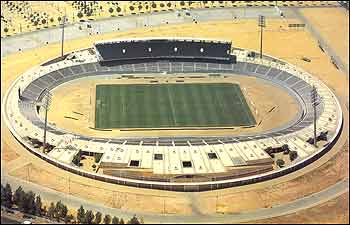 It was the start of a slow decline and by 1984-85, the club was back in the Tercera. By now, El Arcángel was coming towards the end of itself useful life. It had always been susceptible to flooding and the municipality decided in 1991 to build a new multi-sports stadium around 500 metres to the south of the old El Arcángel. This new stadium was only a little bit further away from the troublesome Guadalquivar, but was raised on a circular bank of land to avoid any repeat of flooding.
It was the start of a slow decline and by 1984-85, the club was back in the Tercera. By now, El Arcángel was coming towards the end of itself useful life. It had always been susceptible to flooding and the municipality decided in 1991 to build a new multi-sports stadium around 500 metres to the south of the old El Arcángel. This new stadium was only a little bit further away from the troublesome Guadalquivar, but was raised on a circular bank of land to avoid any repeat of flooding.
Opened on 7 November 1993, The Estadio Nuevo Arcángel featured a curved cantilevered stand on the west side and not a lot else. The stand sat atop a single tier of shallow open seats that ran around the stadium. This tier was separated from the pitch by that pantomime villain of stadium design, an athletics track. The new stadium had a capacity of 15,280 and was not universally loved. In fact, the fans despised it.
After a sixteen absence, Cordoba returned to La Segunda and after a couple of season of staving off relegation, the club and the municipality decided to experiment with the stadium’s layout. Temporary stands were erected at either end of the ground over the athletics track. The pitch was moved towards the west stand leaving the way open for the next major development of the stadium, a huge east Tribuna, which would form part of Madrid’s bid for the 2012 Olympiad. However, just as work was about to start, the plans received two massive body blows. First Cordoba managed to get itself relegated form La Segunda at the end of the 2004-05 season, then during the summer of 2005, Madrid lost out to London in the race to host the Olympics.
Undeterred, Cordoba and the local municipality pressed on with the brave decision to completely redevelop the stadium. The first phase saw the completion of a two tiered east tribuna with a capacity of 8,000. This huge building dominates the skyline of the rather flat and featureless river bed area and incorporates an (empty) 8 story office block at the rear of the stand. Work commenced on the north end of the stadium in September 2007, and little over a year later, the twin deck stand was opened.
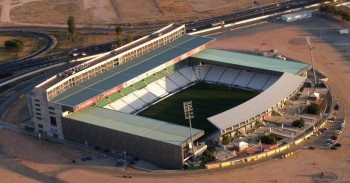 It featured a large bank of white seats on the lower tier and a slim section of green seats upstairs. The two new stands linked seamlessly on the lower tier, but the lower north stand is joined with some rather boxy fascia work on the top level. The south stand is identical to the north and was completed at the start of the 2011-12 season. Plans to replace the existing west stand have been shelved, so with a capacity of 25,000, this phase
It featured a large bank of white seats on the lower tier and a slim section of green seats upstairs. The two new stands linked seamlessly on the lower tier, but the lower north stand is joined with some rather boxy fascia work on the top level. The south stand is identical to the north and was completed at the start of the 2011-12 season. Plans to replace the existing west stand have been shelved, so with a capacity of 25,000, this phase
of the project is complete.
Surprisingly, the Spanish National side has only ever played in Cordoba on the one occasion, a 1-0 friendly victory over Japan in April 2001 in what was the old configuration of the Estadio Nuevo Arcángel. The stadium is a world away from the bland and sterile Estadio Nuevo Arcángel of a decade ago and with Cordoba having its best spell in La Segunda for over forty years, it may not be too long before we see another all-conquering army descend on the city in the shape of La Selección.
_____________________________
To read more on the footballing stadiums of Spain, visit Chris’s excellent site Estadios de fútbol en España
Follow @icentrocampista

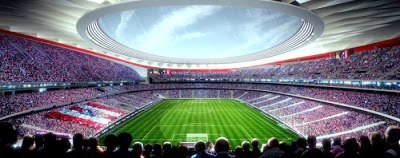
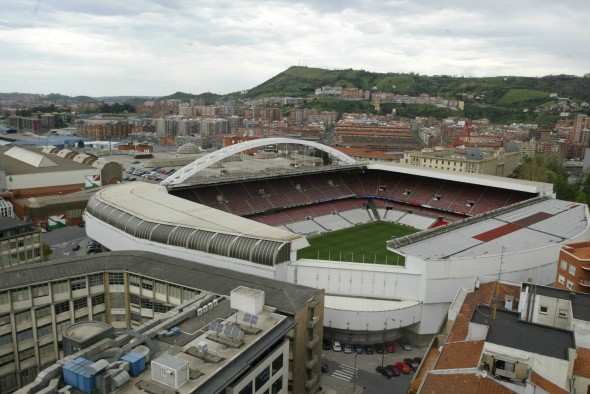
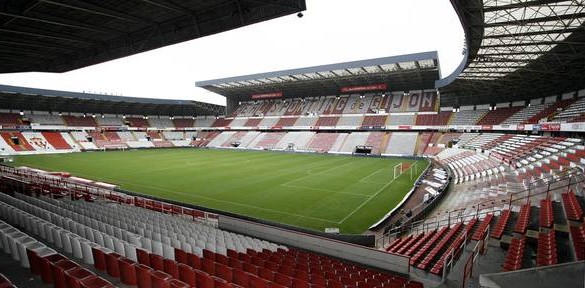


You must be logged in to post a comment Login